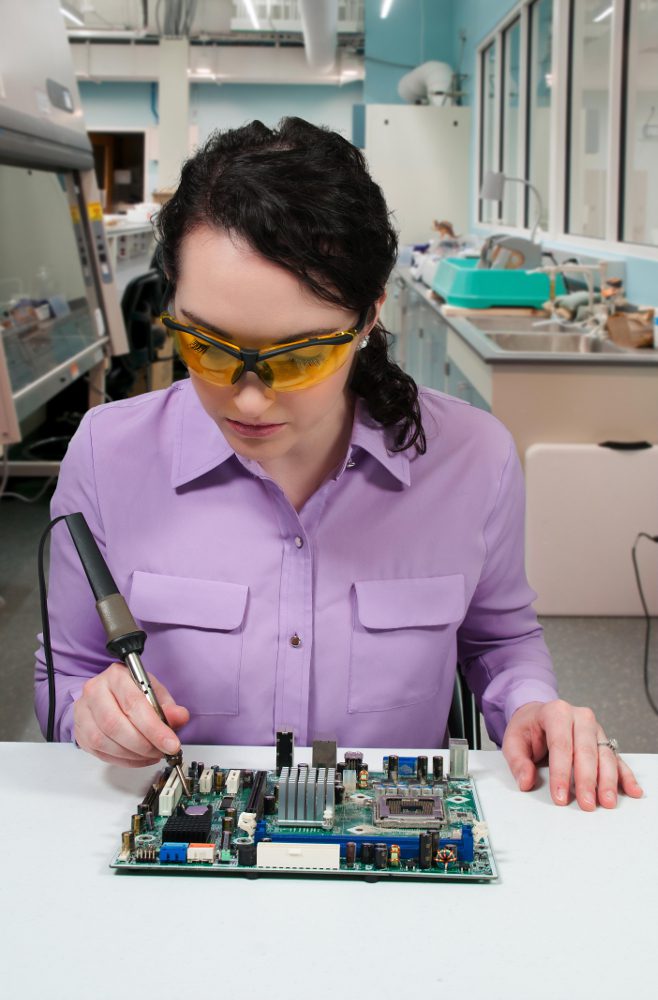Table of Contents:
Err, so I’m thinking of buying one of these kits and using it as an excuse to learn soldering… I’m inexperienced in this field, I’ve seen a soldering iron maybe once in my life, but apart from that I’m technically gifted… Is what I’d like to build too ambitious for a novice, or more in the “risky but achievable” category?
So begins one of the forum threads on Reddit in the r/AskElectronics subreddit – paraphrasing a Redditor. Completely normal stuff. We look at something we like and would like to get into it. The thing is that after the first phase of fascination we take a more critical approach to the matter and we realize that it will take a lot of water before we get to know the area we are interested in enough to move freely in it. In this case we should rather say that it will take a lot of skin burns to heal. Soldering sounds to many like a highly specialized craft reserved for electricians, electronics engineers and related trades.
Let’s listen to what is being said on this subject and dispel all those myths without mercy.
Myth 1: Soldering is dangerous
Everything is dangerous. Swimming is dangerous, and somehow that doesn’t stop swimmers from doing it. Same goes with shooting firearms – but you have to know the safety rules first.
It is no different with soldering, which must also be carried out correctly in workshop, home and field conditions. A switched-on soldering iron is primarily a source of heat. The temperature of a heated tip in a soldering station can reach several hundred degrees Celsius. A poorly used tip can cause serious damage to loose clothing, hair, electrical wiring and the surrounding workspace. Soldering with tin, lead, or other metals used for soldering produces dust and fumes that are dangerous. Just as in an experimental chemistry class, remember to turn on the fume hood at that time. In addition, the use of rosin-containing flux produces solder fumes that, if inhaled, can cause serious illness or aggravate existing asthmatic conditions, as well as irritate the eyes and upper respiratory tract.

Let’s go back to the fact that the soldering iron burns. It can scorch since it heats up to around 400°C when working with tin. A few of Botland team members team has “connected” their hand with the soldering iron and all agree that it does not hurt that much, because such temperature damages nerve endings for a short time. The contact is usually instantaneous, because it is difficult to mistake that you have just touched something heated, so the injury is temporary, too. This is usually due to carelessness and ends up in a small scar at most. The usual home remedies will suffice, and for more troublesome workshop burns, proven remedies will be prescribed by your family doctor. But you’re still obligated to follow safety rules and remember that you can get hurt really nasty when not doing so.
Myth 2: Soldering is for men
A certain horrible photo has circulated the world. The woman depicted in it is the heroine of countless memes with fanciful captions. However, this is not the only such photo in the network, and often in a serious context…
According to many, the photo is actually an insinuation that women can’t solder and perpetuates a gender divide we should have overcome long ago. Look at the right hand of the woman holding – she is holding the heating element of the soldering flask, not the insulated handle that protects against contact with the heated metal parts of the heater. We say a definite no to this perception of women engineers. More and more women are crossing the thresholds of technical universities and secondary technical schools. Soldering does not require great physical strength. The equipment and its elements can be used by children under adults’ supervision. You don’t need anything like a welding mask or protective clothing except for the recommended glasses. These are actually arguments for both genders that feel reluctant to include soldering in their range of skills on many occasions. And speaking of occasions…

Myth 3: Soldering is for professional applications only
This is where gas soldering irons (but not only those) come into the scene, Metal parts soldering can be done in many different ways, so it’s different soldering irons are used for this. Especially models that do not require mains power are becoming popular – such a soldering iron is mobile, and at the same time powerful, because the flame in small-sized models can heat up to over 1000°C. However, handy models are not only suitable for tasks such as soldering small electronic components. Having a soldering iron and knowing how to use it allows you to:
- repair lighting, including LED amplifiers, without replacing the equipment or expensive servicing,
- repair a loudspeaker,
- repair jewelry or creating it by firing, as well as other DIY projects,
- remove unwanted, for example unsightly or malicious, stickers and prints
- prepare dishes such as crème brûlée, where the layers of the dish are slightly browned before serving
- connect electrical wiring and electronic circuits,
- repair pipelines,
- seal roofs or gutters
- flashing.
The soft soldering method, i.e. at operating temperatures below 450°C, is readily used in and around the home. The simple process at this relatively low temperature is not difficult, and all you need is the simplest soldering iron or soldering station. There are plenty of places where soldering will come in handy, and quite a few of the potential applications a lot of us haven’t even thought of.
Myth 4: Soldering is expensive
You will pay for soldering at a jeweler’s. The price usually depends on whether the work to be done is spot or extensive/how extensive, whether something needs to be added, such as an earring or a pin, on the type of jewelry or its age. Older jewelry often requires polishing and cleaning, which costs extra. Soldering is therefore expensive because it costs money.
But why not having a gear and skills to do it by yourself? The cheapest soldering irons cost only a few Euros. The price depends on how the soldering iron works (heater, transformer, hotair, gas, with electrodes, battery), and the price range can be quite wide. There is no catch in what we have to additionaly buy for the soldering iron – as no rifle works without ammunition, it is important to have the right accessories and soldering irons. These do not cost much. Tin and soldering paste prices range from a few to several dozen PLN depending on the weight of the material – and these can be found in the form of smaller vials and larger threads usually wound on a spool. You can solder without flux, but rosin (colophony) and fluxes that make soldering easier and protect copper from oxidation cost a few zlotys, and a dozen grams of the preparation is enough for quite a long time. You can buy a cheap sponge or salmiak for your soldering iron or a slightly more expensive ESD anti-static mat made of rubber for cleaning tips.
Myth 4b: Soldering mistakes are very costly
In the early stages, much can be undone. Beginners will also benefit from the syringe-like suction accessory, a solder sucker, which works for draining out the excess tin when the soldering did not go as you wished. Cost – less than 10 PLN (few Euros).

Myth 5: A soldering station is something far more advanced than a soldering iron
Good morning, are there soldering irons? Oh yeah, we got those in plenty. We got soldering stations, too. Whoa, I don’t want the whole station!
Names of devices can sound overwhelming. A soldering station has temperature control and consists of an electrical power supply, a control circuit with user-adjustable temperature and display, and a soldering iron or soldering head with tip temperature sensor. It’s usually equipped with a stand for the hot soldering iron, which you use when the soldering iron is not in use, and a wet sponge for cleaning – this is usually already included.
It is mostly used for soldering electronic components. Other functions can be combined, for example, a station for extensive rework, although mainly for surface mount components, can be equipped with a hot air gun, a vacuum pick-up tool and a soldering head. A desoldering station will be equipped with a desoldering head with a vacuum pump for desoldering through-hole components and a soldering head. The soldering station is convenient, easy to use stationary working station and many models monitor various parameters for us.

How useful was this post?
Click on a star to rate it!
Average rating 5 / 5. Vote count: 1
No votes so far! Be the first to rate this post.



















